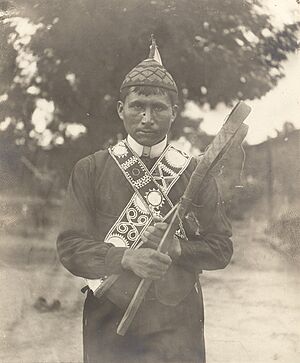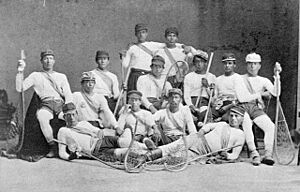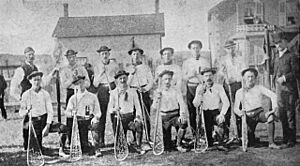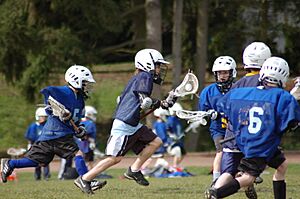History of lacrosse facts for kids
Lacrosse is a super old and exciting team sport! It started with Native American tribes in what is now the United States and Canada. They played a game that was much wilder and bigger than modern lacrosse. Over time, European settlers changed the game a lot to create the version we see in colleges and professional leagues today.
Hundreds of native men would play this ball game using sticks. The game started when the ball was thrown into the air, and both teams rushed to catch it. Because so many players were involved, these games often looked like a huge crowd of players moving slowly across the field, all trying to get the ball. Passing the ball was seen as a trick, and it was considered brave to face an opponent head-on rather than dodge them. Today, lacrosse is still a popular sport played all around the world. The original players wore their normal clothes and used wooden sticks. Teams could have anywhere from 100 to 1,000 players, and they played on fields that were 1 to 2 kilometers long!
Contents
The Original North American Game
Modern lacrosse comes from games played by many different Native American communities. These games had different names, like dehontsigwaehs (meaning "they bump hips") in the Onondaga language, Tewaaraton ("little brother of war") in Mohawk, baaga`adowe ("bump hips") in Ojibwe, and Ishtaboli or kapucha toli ("little brother of war") in Choctaw.
Lacrosse is one of the oldest team sports in North America. There's proof that a version of lacrosse was played in what is now Canada as early as the 1600s. Native American lacrosse was played across modern Canada, but it was most popular around the Great Lakes, the Mid-Atlantic coast, and the American South.
Traditional lacrosse games were sometimes huge events that could last for several days! Imagine 100 to 1,000 men from different villages or tribes playing against each other. The games took place on open plains between the villages, and the goals could be super far apart – from 500 yards to 6 miles!
The rules for these games were decided the day before. Usually, there were no "out-of-bounds" areas, and players couldn't touch the ball with their hands. The goals were often large rocks or trees, but later, wooden posts were used. Games often lasted from sunrise until sunset.
In some versions, especially in the Southeast, players used two sticks and scored points by hitting different parts of a tall pole. Hitting a mark about chest high on the pole was one point. Hitting the top half of the pole, high above anyone's reach, was usually worth two points. The very top of the pole, often decorated with a fish or other sacred animal, was worth three points. In fun games, scoring was often kept loosely by the audience or a few players. Games usually ended when one team reached about twenty points. The Iroquois and Great Lakes styles used poles or goalposts.
The game started with the ball being thrown into the air, and both teams rushing to catch it. Because so many players were involved, these games often looked like a huge crowd of players moving slowly across the field, all trying to get the ball. Passing the ball was seen as a trick, and it was considered brave to face an opponent head-on rather than dodge them.
Medicine men acted like coaches, and the women of the tribe would often help the players and cheer them on. They would also sing while the men played. There was also a women's version of lacrosse called amtahcha in some areas, which used much shorter sticks with bigger heads. Another version women played among the Iroquois and Eastern Woodland tribes was called double ball.
Lacrosse traditionally had many different purposes. Some games were played to settle arguments between tribes. This was very important for keeping the Six Nations of the Iroquois united. Lacrosse was also played to train young warriors for battle, for fun, as part of festivals, and for bets. Finally, lacrosse was played for religious reasons: "for the pleasure of the Creator," and to pray together for something.
Game Day Rituals
Before a game, players had rituals similar to those before going to war. Players would paint their bodies with paint and charcoal. They also decorated their sticks with items that represented qualities they wanted to have in the game. Players had strict rules about what they could eat before a game, and the medicine man performed rituals to prepare players and their sticks. The night before a game, players wore special clothes and held a ceremonial dance. They also made sacrifices and yelled sacred words to scare their opponents.
On game day, teams walked to the field, and their journey was slowed by constant rituals. One ceremony was "going to water," where players dipped their sticks in water, and the shaman gave a spiritual and strategic pep talk. Sometimes players would get ceremonial scratches on their arms or body.
Before the game, every player had to place a bet. Things like handkerchiefs, knives, small treasures, and even horses were part of the bets. The bets were displayed on a rack near the spectators, and items were given out to the winner of each part of the game.
When the game was over, a ceremonial dance took place, along with a big feast for the hungry players.
Traditional Equipment
Some early lacrosse balls were made out of wood. Others were made of deerskin stuffed with hair. They were usually about three inches wide.
The first lacrosse sticks were basically giant wooden spoons with no netting. Great Lakes style sticks had one end bent into a 4 to 5 inch wide circle, which was filled with netting. This netting was made of plant roots or deer sinew. The Iroquois and Eastern Woodland style sticks used a U-shape instead of a circle.
These sticks were bent into shape after being softened by steaming. They usually ranged from 2 to 5 feet long. Lacrosse sticks often had detailed carvings on them meant to help players in the game. Lacrosse sticks were so special that many players asked to be buried with their stick next to them when they died.
Some versions of lacrosse used unusual stick designs. In the St. Lawrence Valley, a version was played where the stick's head took up two-thirds of its length. In the Southwestern United States, a double-stick version was played with sticks about two and a half feet long.
Players in traditional lacrosse did not wear any protective equipment.
Europeans Discover the Game
The first Europeans to see lacrosse were French Jesuit missionaries in the St. Lawrence Valley. In the 1630s, they watched the game and didn't approve of it. They thought lacrosse was too violent, involved too much betting, and was part of the Native American religion they wanted to change.
One missionary, Jean de Brébeuf, was the first to write about lacrosse. He saw the Hurons playing "crosse" in present-day Ontario in 1637. Some people say the name "lacrosse" came from the French term for field hockey, le jeu de la crosse.
Even though the Jesuits didn't like it, many other European colonists found lacrosse fascinating. Betting on games became common, and by around 1740, many French colonists started playing the game. However, it's widely believed they couldn't play as skillfully as the Native Americans.
James Smith wrote in detail about a game played in 1757 by his fellow tribe members. He described them using a wooden ball about three inches wide and a strong staff about five feet long with a hoop net on the end to move it.
In 1763, Ojibwas used a lacrosse game to capture Fort Michilimackinac (now Mackinaw City, Michigan). Native players invited the British soldiers at the fort to watch a lacrosse game. The players slowly moved closer to the fort gates, then suddenly rushed into the fort and attacked the soldiers.
In 1805, during a trip up the Mississippi River, U.S. army officer Lt. Zebulon Pike saw a group of young Ho-Chunk (also known as Winnebago) and Sioux men playing a game similar to lacrosse. This was near the east bank of the river in what is now west-central Wisconsin. He named the area "Prairie de la Crosse," which later inspired the name of both the Wisconsin county and its main city. Today, two statues in the city of La Crosse remember the game Pike saw.
In 1834, a team of Caughnawaga Indians showed off lacrosse in Montreal. While not everyone was immediately excited, interest in lacrosse grew steadily in Canada.
In 1856, William George Beers, a Canadian dentist, started the Montreal Lacrosse Club. He created new rules for the game in 1867. These rules made the games shorter, reduced the number of players, used a new stick design, and used a rubber ball. The first game played under Beers' rules was at Upper Canada College in 1867. During the 1860s, lacrosse became Canada's national summer game. The first games played overseas were in 1867. In 1876, Queen Victoria watched a game and was very impressed, saying "The game is very pretty to watch." Her approval helped many English girls' schools start playing the sport in the 1890s. The Mohawk Lacrosse Club in Troy, New York, became the first organized club in the United States.
As lacrosse became more popular, its violent side was a big problem. The game was banned in some areas when, in 1900, Choctaw Indians were found to have added lead weights to their sticks, making them dangerous.
By the 1900s, many high schools, colleges, and universities had adopted lacrosse as a league sport. Lacrosse became an Olympic sport for the 1904 and 1908 Summer Olympics, but it was then removed as an official sport. After 1908, lacrosse was a sport in the World Games.
In the 1930s, an indoor version of the game, called box lacrosse, was created in Canada. It quickly became the main type of lacrosse in Canada, partly because of the harsh winter weather that made outdoor play difficult.
Smaller leagues developed for box lacrosse and college lacrosse. Two professional leagues were also created: In 1987, the Eagle Pro Box Lacrosse League was founded. It later became the Major Indoor Lacrosse League, and then the National Lacrosse League (NLL). In the summer of 2001, a professional outdoor lacrosse league, known as Major League Lacrosse (MLL), started. In 2019, the Premier Lacrosse League was created, offering players better pay and benefits.
Lacrosse Today
Today, lacrosse is most popular in Canada and the United States, but it's also played in the United Kingdom and Australia. While lacrosse isn't as popular as some other sports, more and more people are playing and getting interested in it. US Lacrosse has reported that kids in America are choosing to try lacrosse instead of other sports. A US Lacrosse survey shows that boys' and girls' lacrosse has grown by 47% and 43.1%. Also, the NCAA reported a 24% increase in new men’s lacrosse programs in colleges over the last two decades, and women’s athletic departments saw a 65% increase in new programs between 1998 and 2008. With more young people playing lacrosse, this will lead to more high school players, then more college players, then more professional players, and finally, more interest in the sport overall.
Even though lacrosse has seen a 35% jump in players since 2012, attendance at MLL (Major League Lacrosse) games had gone down, and the sport didn't get much TV coverage in the US. Paul Rabil, who is considered one of the greatest lacrosse players ever, tried to buy the MLL several times because he was tired of low player wages and poor attendance. But the MLL said no. So, Paul Rabil and his brother, Mike Rabil, decided to create their own lacrosse league called the PLL (Premier Lacrosse League) in 2018. They got financial help from the Chernin Group and Alibaba co-founder Joseph Tsai. The brothers also signed a deal with NBC and NBC Sports to broadcast the league games. The PLL offers a minimum salary of $25,000, which was three times more than what MLL players made, plus health-care benefits and a share in the league's ownership. The PLL has allowed many professional players to make lacrosse their full-time job. This is why many MLL players moved to the PLL, and why many college lacrosse players have chosen the PLL over other professional leagues. With the creation of the PLL, attendance at games increased. In 2019, the PLL's first season, over 10,000 people attended every weekend event, and hundreds of thousands watched from home. With good financial support, marketing, and TV broadcasting, the PLL had a very successful first season, getting more viewers and interest than the MLL. It was a huge success for the sport!
After two seasons, the MLL merged into the more successful PLL in 2021. This made the PLL the only men's professional outdoor lacrosse league in North America.
In 2021, Athletes Unlimited Lacrosse, which is the outdoor lacrosse part of a growing professional women's sports league in the US, started playing games.
See also
- Mesoamerican ballgame
- List of the oldest lacrosse teams
- Native American stickball








